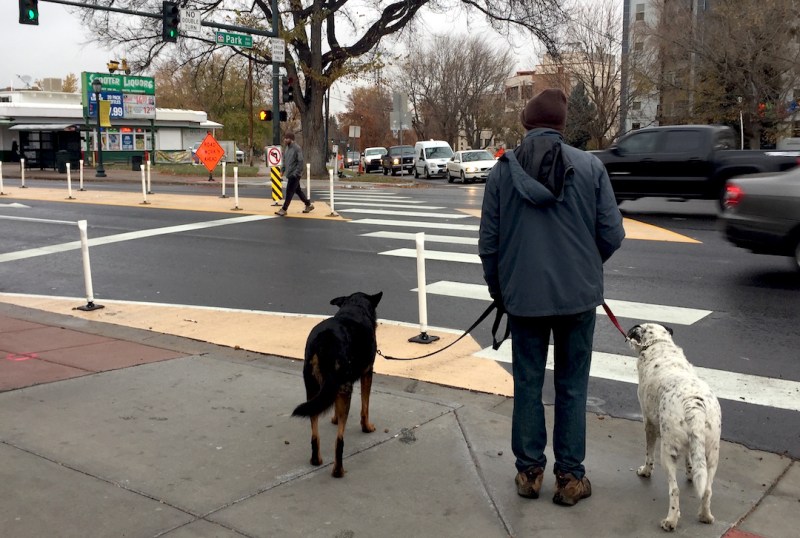Lessons of a “Reformed Engineer”: Small Street Changes, Big Impact on Walkability and Safety

I recently traveled to Colorado Springs in order to hear a speaker whom I have long wished to hear in person. If you don’t know him, Charles Marohn of Strong Towns is a reformed civil engineer — reformed in that one day he looked around at what he was designing, building, and finding funding for, and he realized that what he was doing was increasing his city’s long term maintenance bills while at the same time making it less livable. What’s more, the new projects weren’t even generating enough new tax revenue to cover those new bills. He was making his city financially fragile and an unpleasant place to live.
Marohn realized that what his city needed wasn’t large, expensive “silver-bullet” projects — those huge, state- and federally-funded rebuilds or expansions that try to fix things all at once. What was needed instead were small interventions, little things that make daily life easier, that show care and solve problems. To put it in common nomenclature: build from the bottom up rather than the top down.
The advantage to building this way is twofold: first, it’s much cheaper, and second, it’s more likely to succeed. If your $40 million dollar project doesn’t work out, that’s a terrible loss that you’re on the hook for. But, if two or three of your many two thousand dollar projects don’t work out then you haven’t bankrupted yourself and you can try again. The stakes are so much lower and the payoff so much higher that it’s worth the risk.
From a pedestrian perspective this could mean something like more money for crosswalk paint and less money for adding right-turn lanes. It means inexpensive sidewalk repair rather than pricey road widening. It means painting narrow two-way streets that make a walkable neighborhood instead of three-abreast, one-way mini speedways with twelve-foot lanes that make a place unpleasant to be outside. Consequently, it also means more emphasis on the safety of people than the speed of car traffic.
A couple of problems when trying to do things this new, smaller way are our current method of funding and our sense of order. For example, do you need $80 million dollars for a street upgrade that ticks all the conventional “safety” boxes while simultaneously entrenching high-speed car traffic? There’s a budget for that, hundreds of millions of dollars set aside at the federal and state levels. But what if you want to paint a crosswalk next to a park? Not only is there no money for such a thing, it’s actively discouraged in case it could seen as “confusing” and “unnecessary.”
As Marohn frames it, the first item is orderly, but dumb. Everything is carefully reviewed and standards are assiduously followed, even if the result is less livable. The second item is smart but chaotic — people in the neighborhood can see the need and the solution — and given nothing more than a bucket of paint would do it themselves — but traffic manuals argue against it and no city money is provided for such unsanctioned livability.
Marohn argues for a different paradigm when it comes to building cities: rather than finding a congested street, procuring funds, and redesigning it from the top down, we should instead go out into the community and simply watch. Don’t engage, don’t hire consultants, just observe. Look for those places where you see people using city infrastructure “incorrectly.” Crossing mid-block. Dodging high-speed traffic at unsignalized intersections. Avoiding certain places due to a perceived or actual lack of safety. Once you’ve identified what people are trying to accomplish, like crossing the street to get to the store or getting to the park without driving, you can start to think of ways to improve those experiences. That’s not to say you should think of ways to force people to use the broken design that’s in place, but instead you should change the design in ways to adhere to human needs.
As noted above, these interventions don’t have to be enormous capital projects. They don’t require huge amounts of planning and years of study and months of community input. What they require is a little patience, a little honest observation, and a willingness to acknowledge that the current system isn’t working. If painting a crosswalk at the park makes things worse, well, we’re out several hundred dollars worth of paint. If it makes things better, hey, we’ve made a safer space for park visitors at very little cost. If that $30 million dollar intersection rebuild adds sidewalks but increases high-speed car traffic and reduces walkability (think of our brand-new Broadway & Mississippi rebuild) then we’ve wasted $30 million bucks and made things worse. If we keep making little bets on paint and livability, we’ll end up with a better city even if we occasionally get it wrong. On the other hand, if we keep building more intersections like Broadway and Mississippi, or widening streets like Quebec, we’ll end up broke and a place where no one wants to be, only wanting to drive through as quickly as possible. We have to allow ourselves to think differently — smaller, more livable, and for people.
John Riecke lives in Denver.


